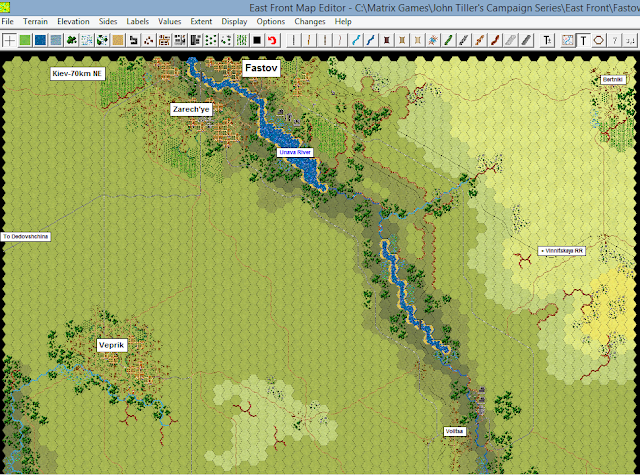Last Eagles - "Narrative building" at Ligny
 |
| Out of command units from Vandamme's III Corps move around Von Zieten's flank. |
Each commander has a range (at Ligny that range is 8 hexes) within which commanders can exert their influence. If a unit strays outside that range, they are considered out of command and executing independent movement.
To move independently, a unit has to undergo a stress test of sorts, by rolling 2D6 to see if the roll is equal to or less than the boxed number at the bottom of each counter (unit quality factor). On top of that, they can only move half the distance they normally would under command.
In my first play through of Scenario 1 and possibly because of my initial setup, Vandamme's flanks begin the game out of command. In fact for the first two turns, they would remain outside Vandamme's command range as they struggled to maintain marching order and cohesion (pass their stress tests) as I sent them around von Zieten's left flank in an effort to turn the Prussian lines.
It did eventually happen for me (but during the second activation of Turn 3 and in a very piecemeal fashion). See below.
 |
| Vandamme's right flank joins the fray after 5PM on June 16 forcing von Zieten to retreat to avoid encirclement. |
The tension their struggles to march around von Zieten's flank created for me as the French commander was palpable. I could almost imagine Vandamme (known to be brutish and hot-tempered) berating his orderlies as he promised to hang the wayward regimental commanders from St. Amand's lovely church steeple. Doug at Cry Havoc smartly called this "narrative-building" and I think he is dead on, which brings me back to Last Eagles.
This game does what all game designers want, it tells a story about Napoleonic warfare. The charms, the frustrations, the artfulness, the carnage, all of it. This is one rule, maybe two paragraphs of text in total, but it made me hang on every activation phase and die roll as I willed the regiments forward into St. Amand. Victory hangs in the balance and their timely or untimely arrival might be the difference. What a story!
Well done Hexasim!


Comments
Also remember that Girard’s Division from Reille’s Corps is included in this attack.
I’m about to play Scenario #1 for a second time, having learned much from my first play despite the mistakes with rules and tactics. Hopefully I’ll feel much more comfortable with the system this time. But make no mistake, I like the system.
I kept the Prussian reinforcements out of my first playthrough and removed the cavalry rules to try to simplify things. I can't wait to start using formation orders and i agree about their inclusion in scenario 1.
PS. Reading your posts made me interested for this game :)
Chris Ad